Bengal Tiger
- February 8, 2024
- 0 comment
The Bengal Tiger, scientifically known as Panthera tigris tigris, is a magnificent and iconic big cat species that resides primarily in the Indian subcontinent. It is renowned for its striking appearance, characterized by a vibrant orange coat adorned with dark, distinctive stripes, and it’s this unique pattern that makes every individual Bengal tiger truly one of a kind. These majestic creatures are among the largest of all wild cats, with adult males weighing between 400 to 600 pounds and reaching lengths of up to 10 feet, including their tail.

Bengal tigers are top-of-the-food-chain carnivores, displaying remarkable stealth and strength in their hunting techniques. They inhabit a variety of landscapes, from dense mangrove forests to grasslands and deciduous jungles, and their territory can span across India, Bangladesh, Nepal, and Bhutan, making them the most widely distributed tiger subspecies.
| Characteristic | Description |
|---|---|
| Scientific Name | Panthera tigris tigris |
| Appearance | Vibrant orange coat with distinctive stripes |
| Size | Adult males: 400 to 600 pounds |
| Length: Up to 10 feet (including tail) | |
| Habitat | Mangrove forests, grasslands, deciduous jungles |
| Range | India, Bangladesh, Nepal, Bhutan |
| Carnivorous Diet | Prey includes deer, wild boar, water buffalo |
| Hunting Style | Stealthy ambush hunters |
| Territorial Behavior | Establish dominance over large territories |
| Reproduction | Mating throughout the year, 2-4 cubs per litter |
| Conservation Status | Endangered due to habitat loss and poaching |
| Importance | Vital role in maintaining ecological balance |
| Cultural significance in native regions |
A Roar of Elegance in the Wild
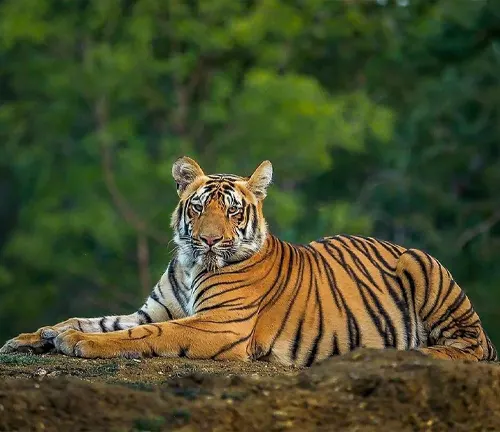
In the heart of the lush jungles and dense forests of the Indian subcontinent, an apex predator reigns supreme – the Bengal Tiger (Panthera tigris tigris). This awe-inspiring creature is not just a symbol of raw power but also a testament to the exquisite beauty of nature. Join us on a journey through the mesmerizing world of Bengal tigers, as we explore their habitat, behavior, conservation status, and the importance of preserving these magnificent creatures.
Bengal Tiger’s Habitat

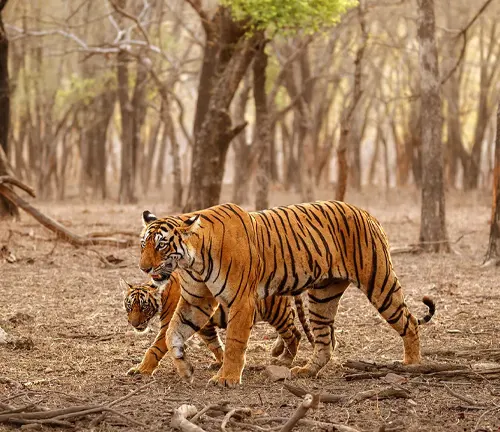
Mangrove Forests
Bengal tigers can be found in the dense mangrove forests along the coastlines of India and Bangladesh. These unique ecosystems provide both cover and access to prey species that inhabit the coastal regions.
Grasslands
They also thrive in grasslands, where the open terrain allows for effective stalking and hunting. Tall grasses offer camouflage, making it easier for them to ambush their prey.
Deciduous Jungles
Bengal tigers are often associated with deciduous jungles, which are characterized by trees that shed their leaves seasonally. These jungles provide abundant cover and are home to a variety of prey species.
Mixed Landscapes
Their habitat isn’t limited to a single type. Bengal tigers are adaptable and can be found in mixed landscapes that combine forests, grasslands, and water bodies, offering a diverse range of hunting opportunities.
Range
The Bengal tiger’s range extends across several countries, including India, Bangladesh, Nepal, and Bhutan, making it the most widely distributed tiger subspecies. This extensive range highlights their adaptability to different environments.

Bengal Tiger Physical Characteristics
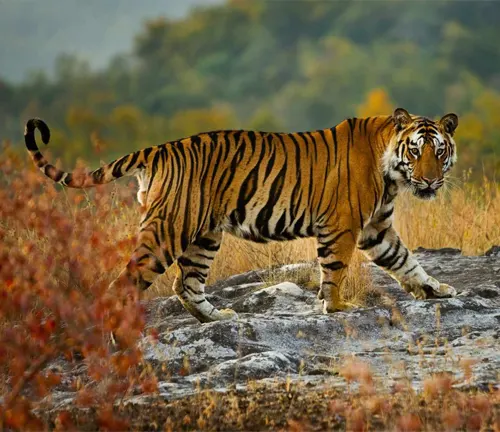
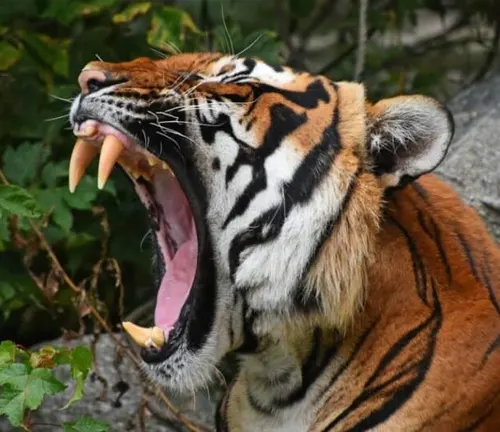
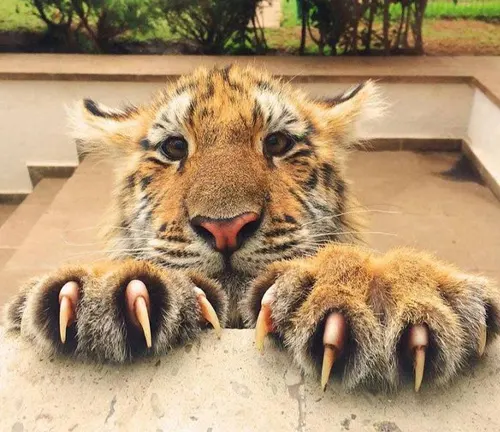
- Coat and Stripes: Bengal tigers have a stunning coat that is predominantly a vibrant orange color, which provides effective camouflage in their lush habitats. Their most distinctive feature is the dark, bold black stripes that crisscross their body. Interestingly, no two tigers have the same stripe pattern, making each individual unique.
- Size and Weight: Among the largest of all wild cats, Bengal tigers exhibit sexual dimorphism, with males being larger than females. Adult males typically weigh between 400 to 600 pounds (180 to 270 kilograms). They can reach lengths of up to 10 feet (3 meters), including their tail.
- Facial Features: Their facial features include piercing yellow eyes, a prominent white muzzle, and black markings that resemble “eyeliner” around their eyes. These facial characteristics add to their mystique and beauty.
- Paws and Claws: Bengal tigers have powerful padded paws with retractable claws, which they use for both climbing trees and capturing prey. These claws can extend to grasp and hold onto their prey securely.
- Teeth: They possess a formidable set of sharp teeth, designed for tearing into the flesh of their prey. Their canine teeth are particularly long and robust, enabling them to take down large animals.
- Ears and Tail: Their ears are rounded and have excellent hearing, helping them detect the slightest sounds of potential prey or threats. The tail of a Bengal tiger is long and striped, matching the body pattern, and serves both as a balance aid and a form of communication.
Hunting and Diet
Carnivorous Predators
Bengal tigers are carnivorous predators with a diverse diet that includes a range of animals. Their diet consists primarily of the following:
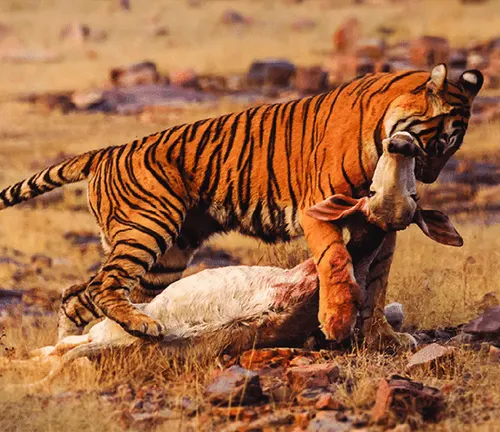
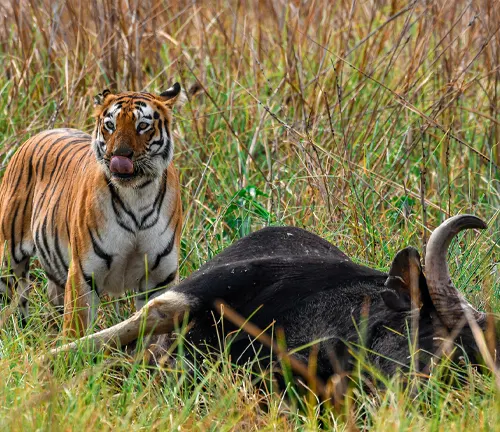
- Deer: Various deer species, such as sambar deer and chital, form a significant portion of a Bengal tiger’s diet. These large herbivores provide substantial sustenance.
- Wild Boar: Wild boars are another staple in the Bengal tiger’s diet. These animals are relatively abundant and provide a source of protein and sustenance for the tigers.
- Large Water Buffalo: In some cases, Bengal tigers are known to hunt and bring down large water buffalo. This requires tremendous strength and cooperation among multiple tigers, as water buffalo are formidable prey.
- Other Mammals: Bengal tigers are opportunistic hunters and may also consume smaller mammals like monkeys and hares when larger prey is scarce.
Hunting Style
Bengal tigers are renowned for their stealth and ambush hunting techniques. They rely on their exceptional camouflage, using their vibrant orange coat with dark stripes to blend seamlessly into their surroundings. They patiently stalk their prey, often approaching as close as possible before launching a rapid and powerful attack. With their powerful jaws and sharp teeth, they deliver a fatal bite to the neck or throat of their prey, ensuring a swift and effective kill.
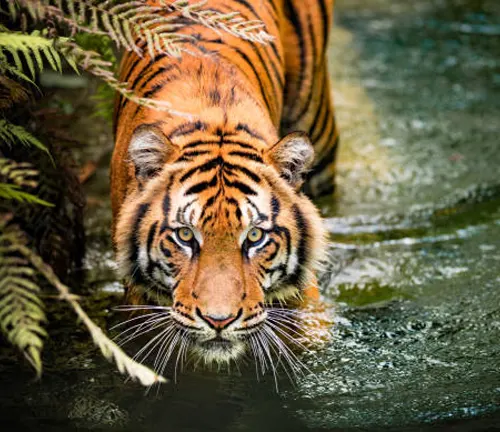
Territorial Behavior
Bengal tigers are highly territorial animals, and each individual establishes dominance over a vast territory. They mark their territory through scent marking, urine, and vocalizations, which help deter other tigers from encroaching on their hunting grounds.
Reproduction and Family Life
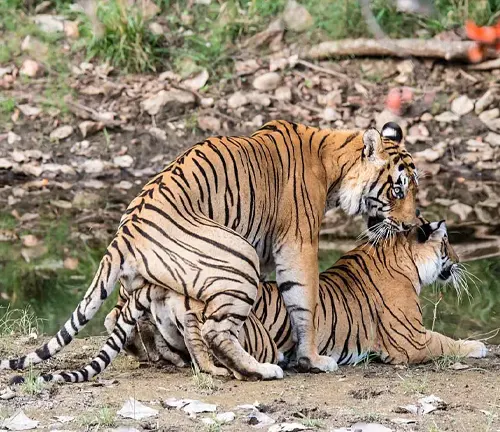
Mating and Gestation
- Bengal tigers are not bound by a specific breeding season and can mate throughout the year. When a female is in estrus, she emits scent markings and vocalizations to attract potential mates.
- After mating, the female’s gestation period lasts approximately 3.5 months, or around 100 days.
Birth and Cubs
- A female Bengal tiger typically gives birth to a litter of 2 to 4 cubs, although larger litters are possible.
- The cubs are born blind and helpless, weighing around 2 to 3 pounds (1 to 1.4 kilograms) at birth.
- The mother finds a secluded den or sheltered area to give birth and nurse her cubs, ensuring their safety from potential predators.
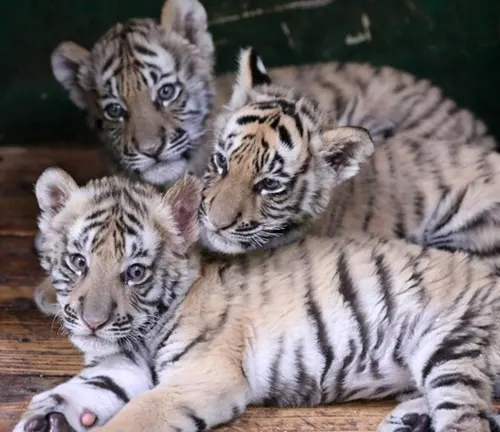
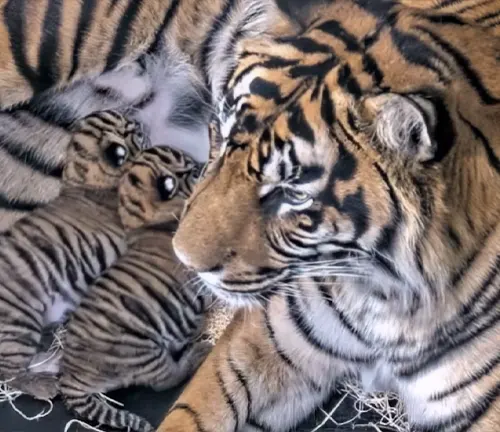
Maternal Care
- Mother tigers are incredibly devoted to their cubs, providing intensive maternal care for the first few months of their lives.
- They nurse their cubs with rich, nutritious milk, helping them grow and develop rapidly.
- As the cubs begin to grow, the mother introduces them to solid food by bringing back prey, which she has hunted.
- Over several months, she imparts essential survival skills to her cubs, teaching them to stalk, pounce, and eventually hunt.
Conservation Status
Endangered Species
- The Bengal Tiger (Panthera tigris tigris) is classified as an endangered species by the International Union for Conservation of Nature (IUCN). This classification is primarily due to the significant decline in its population in the wild.
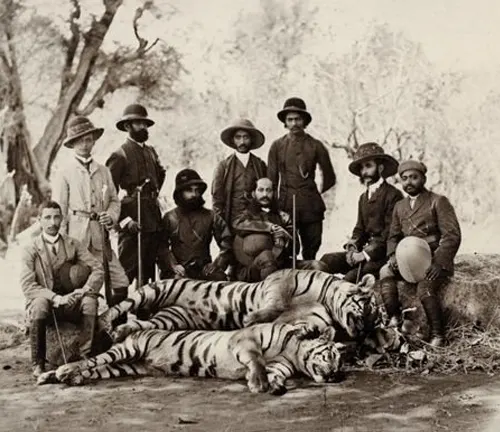
Habitat Loss
- One of the major threats to Bengal tigers is habitat loss. Rapid deforestation, human encroachment, and infrastructure development have resulted in the fragmentation and degradation of their natural habitats.
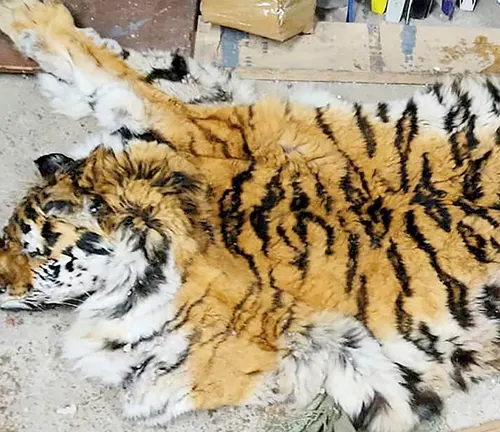
Poaching and Illegal Wildlife Trade
- Poaching for their highly valuable body parts, such as skin, bones, and organs, continues to pose a severe threat to Bengal tigers. The illegal wildlife trade remains a significant challenge, driven by demand in various markets, including traditional Chinese medicine.
Human-Wildlife Conflict
- As human populations expand into tiger habitats, conflicts often arise. Tigers may prey on livestock, leading to retaliation by local communities, which can result in the killing of tigers.
Conservation Efforts
- Various governments, wildlife organizations, and conservationists are actively engaged in efforts to protect Bengal tigers. These initiatives include:
- Establishing protected areas and national parks where tigers can thrive.
- Implementing anti-poaching measures to combat illegal hunting and trade.
- Promoting habitat conservation and restoration.
- Raising awareness about the importance of tiger conservation.
- Supporting community-based conservation programs to reduce human-wildlife conflicts.
Population Estimates
- Accurate population estimates for Bengal tigers are challenging due to their elusive nature and remote habitats. However, it is estimated that approximately 2,500 Bengal tigers are remaining in the wild, although these numbers can vary.
The Way Forward
- The conservation of Bengal tigers is a global priority. Efforts are ongoing to strengthen protection measures, increase habitat connectivity, and reduce demand for tiger products. Additionally, research and monitoring play a crucial role in understanding their populations and behaviors better.
Different Species
The term “Bengal Tiger” typically refers to a specific subspecies of tiger known as Panthera tigris tigris. However, there are no different species of Bengal Tiger.
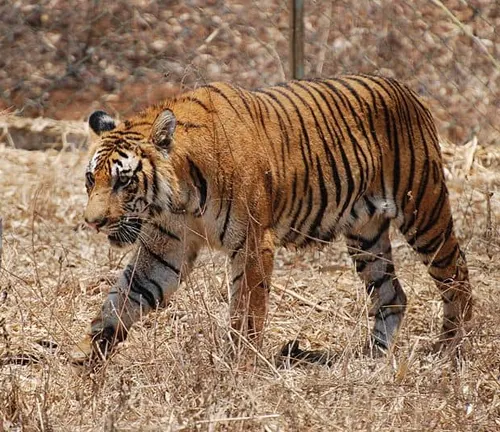
Frequently Asked Questions (FAQs)
1. What is a Bengal Tiger?
A Bengal Tiger (Panthera tigris tigris) is a subspecies of tiger native to the Indian subcontinent, known for its striking orange coat with distinctive black stripes.
2. Where do Bengal Tigers live?
Bengal Tigers primarily inhabit the lush jungles, grasslands, and mangrove forests of India, Bangladesh, Nepal, and Bhutan.
3. How big do Bengal Tigers get?
Adult Bengal Tigers can weigh between 400 to 600 pounds (180 to 270 kilograms) and reach lengths of up to 10 feet (3 meters), including their tail.
4. What do Bengal Tigers eat?
Bengal Tigers are carnivorous predators and prey on animals like deer, wild boar, water buffalo, and occasionally smaller mammals.
5. Are Bengal Tigers endangered?
Yes, Bengal Tigers are listed as endangered by the International Union for Conservation of Nature (IUCN) due to habitat loss and poaching.
6. What is being done to protect Bengal Tigers?
Conservation efforts include creating protected areas, anti-poaching measures, habitat restoration, and raising awareness about tiger conservation.
7. How many Bengal Tigers are left in the wild?
Population estimates vary, but there are approximately 2,500 Bengal Tigers remaining in the wild, although exact numbers are challenging to determine.
8. What is the significance of Bengal Tigers in their native cultures?
Bengal Tigers hold cultural significance in the regions where they reside, often revered as symbols of strength and beauty.
9. Can Bengal Tigers swim?
Yes, Bengal Tigers are excellent swimmers and are known to swim across rivers and lakes to cool off and catch prey.
10. How can I support Bengal Tiger conservation efforts?
You can support conservation by donating to reputable wildlife organizations, spreading awareness, and advocating for stronger wildlife protection laws.












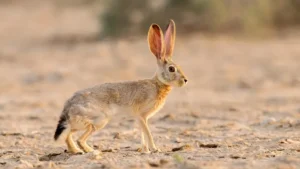

Leave your comment